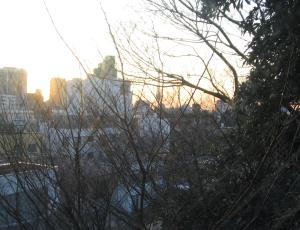The
Iaido Journal Oct 2005
The ‘Kashima Jingu Gasshuku’ Experience
copyright ©
2005 Ray
Sosnowski,
all rights reserved
The “Kashima Jingu Gasshuku” Experience –
My First Trip to Japan for a Jodo Gasshuku
Raymond Sosnowski, Maryland (USA);
President, Northern VA Budokai, Inc.
11 April 2005
Author’s Note
The above title, “The ‘Kashima Jingu Gasshuku’ Experience” refers to
titles from seminar reports of Jodo Gasshuku in Maryland in 1998 and
1999 that I had previously written about (Sosnowski, 1999, 2000).
Much has happened (“interesting times”) since those heady days and more
than a little turmoil in jodo training resulted.
By January 2005, I was ready to reestablish personal contact with the
man that I consider to be my Jodo teacher, Kaminoda Tsunemori sensei of
Tokyo, Japan, after almost four and a third years of separation.
I had attended all five of Kaminoda-s.’s annual Gasshuku in Maryland
from 1996 through 2000; I published seminar reports on all but the
first Gasshuku (Sosnowski, 1998a, 1999, 2000, 2001).
For those who are unfamiliar with the art as taught by Kaminoda-s.,
Shindo Muso Ryu or SMR consists of Shindo Muso Ryu Jodo (the “way of
the stick”), Kasumi Shinto Ryu Kenjutsu (the “art of sword-usage”),
Uchida Ryu Tanjo-jutsu (“walking-stick art”), Isshin Ryu
Kusarigama-jutsu (“sickle-and-chain art”), Ikkaku Ryu Jutte-jutsu
(“forked-truncheon art”) and Ittasu Ryu Hojo-jutsu (“rope-tying art”)
[author’s ‘translation’ of the arts].
Concept: The ‘Kashima Jingu Gasshuku”
Experience
Let me explain this concept as I understand it quoting from my article
on the 1998 Gasshuku:
This year [1998] Kaminoda-s. wanted to bring the “complete” Kashima
Jingu Gasshuku experience to us; this prompted a change of location
from the gymnasium of St. John’s College in Annapolis, MD, where the
previous two Gasshuku [1996 & 1997] were held, to Catoctin Mountain
Park in western Maryland, so that we could all eat, sleep, train and
socialize together and not be distracted by outside concerns [emphasis
added]. I am sure that most, if not all, would agree that we had
indeed experienced the essence of the Kashima Jingu Gasshuku.
(Sosnowski, 1999).
That is, the Gasshuku takes place at a self-contained facility.
Kashima Shimbuden in Kashima City, Ibaraki Prefecture, while having
more
of suburban than rural setting in Maryland’s Catoctin Mountain Park,
fit the bill quite nicely. Even better was the large dojo;
although unheated, it was tolerable (better that than the hot and
extremely humid Japanese summers).
Introduction
Kaminoda-s., as head of the Nihon Jodokai, holds Jodo Gasshuku twice a
year in Kashima City, a rather pleasant change from Tokyo.
Typically these Gasshuku are held in Feburary (or March) and September
(or October or November). Although the training emphasizes Jodo,
one or more of the minor arts may also be included – this year it was
Kusarigama-jutsu. What made this Gasshuku even more tempting was
that Sensei planned to stay on for two more days of training after the
Gasshuku for additional training with the visiting students from
outside of Japan.
First ‘Day’ in Japan (Friday-Saturday,
4-5 Feb. 2005)
I met my sempai and the practice leader of the Northern Virginia
Jodokai, Dr. Dan Pearson of Silver Spring, MD, at Narita Airport at the
currency exchange just outside of Customs & Immigration; he had
come by a different airline through San Francisco. (And it is
true that people in Japan think that when you are saying “Jodo” that
you are mispronouncing “Judo.”) We got train tickets for the
hour-long ride from Narita to Ueno Station in Tokyo; then we rode the
Ginza Line subway to Aoyama Itchome Station where we went to Hotel Asia
Center of Japan to stay for the night.
Tokyo sunrise from my hotel window;
in the background just to the right
of center is the Tokyo Tower (photo courtesy of the author)
Dan had to do a bit of shopping so after we checked in and freshened
up, we went back out to the subway to get to the stores he was
interested in. While we were out, two fellow students from
Wisconsin, Drs. Rich Friman and Claude Gilmore, had arrived and checked
into the hotel. We all met for breakfast the next morning.
Afterwards Mr. Araki from Tokyo came to pick us up and drive us to
Kashima City – four hefty gaijin and their gear in a compact Japanese
station wagon took a bit of doing, but we managed to get everything in
finally since we used lap space as well – there was no need for
air-bags for the three of us in the back.
Side Trip to Katori Jingu (Saturday, 5
Feb. 2005)
We broke up the morning trip to Kashima City by stopping at Katori
Jingu (Shrine) in Sawara City, Chiba Prefecture, which as on the way.
Katori Jingu, one of the oldest shrines in Japan, is dedicated to the
martial deity Futsu-nushi no Okami (aka Iwainushi no Mikoto) according
to an English language handout (also see Bocking, 1997). After
entering via the first torii, Aaraki-san took us off to the left on a
steep side path; we passed several small shrines, including one
dedicated to the fox deity.
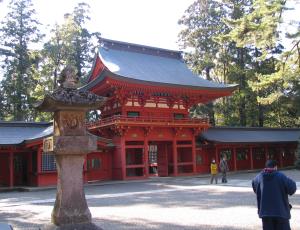 The Romon at Katori Jingu (photo
courtesy of Dan Pearson)
The Romon at Katori Jingu (photo
courtesy of Dan Pearson)
When we reached the summit, we passed through the magnificent red romon
(tower gate), approaching the haiden (hall of worship). We paid
our respects by performing hairei, an individual form of Shinto worship
(Bocking, 1997): make a small monetary offering (saimotsu) by tossing a
few coins into the offertory box (saisen-bako), bow once or twice, clap
hands (kashiwade) once or twice, and bow again. Before leaving we
bought ema (wooden votive tablets), omamori (talismans) and other small
mementos from the adjacent shrine shop.
Again, Araki-san directed us to another side path to lead us back
down. We went down a path through the hillside, which contained
huge cedar trees and giant timber bamboo (madake). We stopped at
a set of stone stairs leading to a small fenced area that contained a
large grave marker. This was the grave of Izasa Choisai Ienao
(1386 – 1488), the founder of Tenshin Shoden Katori Shinto Ryu
(Draeger, 1973), one of the oldest (some claim the oldest) ryuha in
Japan. It was a short photo-op for us before returning to our car
for the short trip to Kashima City.
Gasshuku Day 1 (Saturday, 5 Feb.
2005)
We were one of the first groups to arrive at Kashima Shimbuden; we
quickly unloaded, found our assigned room (the gaijin had a pair of
adjacent bunk rooms) on the second floor, and we settled in. Each
of the regular dorm rooms had five pairs of bunks complete with
tatami. We gathered our futons, makura (buckwheat hull pillows)
and kakebuton (comforter), along with the associated linens, and made
up our sleeping quarters; this was a rather unique aspect of the
“Kashima Jingu Gasshuku Experience.” One of two gaijin living in
Japan, Mike Rogers, came around and handed out information packages
prepared for us foreigners including an English language
schedule. By previous arrangement, he had also picked up
suede-soled tabi for us, which proved to be very handy in the unheated
dojo.
After signing in and paying our Gasshuku fees, we all met in the dining
hall for lunch and several welcome speeches. I recognized a
number of Kaminoda-s.’s senior students from the annual Gasshuku that I
had attended in Maryland from 1996 through 2000, and they, like Sensei,
remembered me. It has been a few years since I ate a group meal
like this, but this was the first time I ate Japanese style; group
dining is a significant part of the “Kashima Jingu Gasshuku
Experience.” For dessert, we had bonton, a kind of super-thick
skinned grapefruit that Sensei had shipped from his hometown on Kyushu
(that thick pulp between the outer skin and the fruit is used to make a
kind of popular Japanese candy); this continued throughout our
stay.
Sensei had brought a large number of supplies with him – mostly weapons
(jo, tanjo, bokuto, shoto, kusarigama and jutte & tessen) and books
[Jodo Kyohan (aka the “big book”), Jyodo (for Seitei Jo Gata), Isshin
Ryu Kusarigama-jutsu, and Ikkaku Ryu Jutte-jutsu & Ittasu Ryu
Hojo-jutsu – we expect to see Kasumi Shinto Ryu Kenjutsu & Uchida
Ryu Tanjo-jutsu published before the end of the year]. Dan had
pre-ordered jo, tanjo, bokuto, and shoto for our students which we
picked up after lunch; Dan also picked up a kusarigama for a sempai,
and I picked up one for myself (Dan had picked up a jutte & tessen
set for me at the February 2004 Gasshuku last year). As the
weapons used in the SMR arts are standardized, and the specialized
weapons like jutte and kusarigama are unique and specially made, the
“weapons bazaar” is a recurring aspect of the “Kashima Jingu Gasshuku
Experience.”
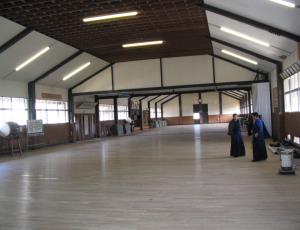 Inside the dojo at Kashima Shimbuden
(photo courtesy of the author)
Inside the dojo at Kashima Shimbuden
(photo courtesy of the author)
After lunch, we changed into keiko-gi and hakama, and went to the dojo
for the formal opening of the Gasshuku. The dojo is a short walk
from the dormitory past a small orchard of Japanese plum trees, and
several trees had a few early blossoms (by contrast, in a sheltered
orchard just outside of Katori Jingu the trees were almost at peak
blossom); from this fruit, the owners made their own umeboshi (salted
pickled plum), which was served with every meal including breakfast
[umeboshi was as ubiquitous as meshi (rice), miso soup and o-cha (green
tea) with every meal]. The sun was bright although the air was
cool (daytime temperatures were in the mid-40’s while the nighttime
temperatures fluctuated around freezing). The dojo was cool, but
not unpleasantly so; even so, those previously obtained tabi were good
to have in the dojo. The unheated dojo (in winter, and uncooled
in summer) is an aspect of the “Kashima Jingu Gasshuku Experience”
relatively unique to Japan.
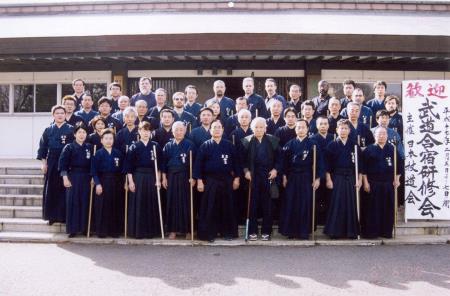 Gasshuku attendees in front of the
dojo entrance at Kashima Shimbuden
(photo courtesy of Kaminoda-s.)
Gasshuku attendees in front of the
dojo entrance at Kashima Shimbuden
(photo courtesy of Kaminoda-s.)
The attendees, who numbered about 50, were divided into four
groups. I found myself moved up to the advanced group with the
rest of the gaijin. We spent the afternoon working on the first
half of the Kage set (the Ura Gata of the Omote set) with Abe Osamu
sensei; he had attended the 1st Maryland Jodo Gasshuku in 1996.
During the break at mid-afternoon, small cans of hot tea, coffee and
cocoa were brought in for us; this little “ritual” would continue
throughout our entire stay. In the late afternoon we broke for
dinner, and then returned to the dojo in the evening for
Kusarigama-jutsu; Amdur (2002) has a nice introduction to this
interesting weapon including our particular version. Sensei led
us through four kata, three from the Omote set and one from Ura.
Thus I was able to break in my newly acquired kusarigama. After
practice and a trip to the ofuro (Japanese hot tub), small parties
broke out in several dorm rooms; the gaijin and a few of the younger
Japanese students assembled in an adjacent dorm room.
Post-training socializing is an integral part of the “Kashima Jingu
Gasshuku Experience.” With the fatigue from jet lag setting in, I
left the party uncharacteristically early.
Gasshuku Day 2 (Sunday, 6 Feb.
2005)
We assembled in the courtyard in front of the dojo at 7 AM to raise the
flag and sing Kimi Gayo in Japanese (Michael’s info. Package contained
the lyrics in Romanji); it was a sunny but cool day. Afterwards
we went into the dojo for warm up exercises and kihon (basics)
practice. After breakfast, we left for the morning to visit
Kashima Jingu and the gravesite of Tsukahara Bokuden – I will highlight
these separately below. We returned to Shimbuden for lunch.
After lunch, I found some time for shakuhachi (Japanese 5-hole,
end-blown bamboo flute) practice (I have practiced Kinko Ryu for two
years with the Kisuian Dojo headquartered in New York City, and I was
preparing for my monthly lesson with my teacher for the Sunday after my
return from Japan). Early morning pre-breakfast training is a
standard part of the “Kashima Jingu Gasshuku Experience,” but you do
have to be in Japan to visit the shrines.
In the dojo after lunch, I somehow got volunteered to “play” the
o-daiko, a large two-headed drum that rests horizontally in a
cradle. Sensei had talked about it the previous day, and said
that it was important for us to be able to do it well when called upon
during mokuso (short meditation before and after class). He had a
group of his seniors at one o-daiko in front of the shrine in the other
wing of the dojo and a group of beginners at the o-daiko in front of
the shrine in our wing. One-by-one members from each group took
turns beating out the rhythm – three long, seven short and two long
beats. I decided to go last in our group as the other members
were Japanese – I wanted to observe as much as possible before my
turn. The beater was the size of a wakizashi; I took a position
like jodan but with my hand above my shoulder and struck the drum head
as I have cut tatami-omote with a wakizashi. The drum responded
with a deep resonant sound that seemed to filled the dojo.
Although I do not recall how well I “scored,” I do recall Sensei saying
that I had done rather well for my first time. The o-daiko
experience is news to me – it’s almost unknown outside of Japan.
Our group continued working on Kage, getting through the first nine of
fourteen kata with Yamaguchi Mitsuru sensei; he was well known among
the gaijin, having attend the 1st, 3rd, and 5th Maryland Jodo Gasshuku
in 1996, 1998 and 2000, respectively. A couple of the Japanese
who could not get Monday off left quietly in the evening. We
changed into “civies” for dinner because dinner was followed by the
official group party, another aspect of the “Kashima Jingu Gasshuku
Experience.” We began with Kirin beer, followed by sake and
finally local plum wine. When we broke up, it was time for the
ofuro and the smaller group parties. However, the fatigue really
hit me hard, and, once horizontal, I did not move from my bunk until
early the next morning when I went to the ofuro for a quick shower
before the start of the day’s activities.
Trip to Kashima Jingu (Sunday, 6 Feb.
2005)
After breakfast, we piled into cars with our equipment and took the
approximately 3-mile trip to Kashima Jingu. I realized only when
we were leaving that we had made a one-way trip through the shrine
grounds, and I was not able to take pictures of the entrance way and
the shrine (the cars had been moved from the front entrance to the back
entrance to facilitate our trip). There was a large elaborate
chouzuya, a pavilion for the purification ritual (washing the hands and
rinsing the mouth – ritual purity is an important aspect of Shinto)
before approaching the shrine. We walked up the path until we
came to the place to pay our respects and make an offering.
Kashima Jingu, which is traditionally twinned with the nearby Katori
Jingu, is dedicated to the warrior-kami Taka-mika-zuchi whose story is
told in the ancient Japanese text Kojiki (“Records of Ancient Matters,”
712 C.E.) (Bocking, 1997). We walked a distance behind this
shrine to visit a stone in a small enclosure, called kaname-ishi, that
is believed to be the stone that the warrior-kami had extracted from
the head of a giant catfish to seal down the earthquake kami, Nai, who
also has the form of a giant catfish (Bocking, 1997). Sensei gave
a short speech here before we returned to the shrine.
There is a wide boulevard that connects this shrine to the
shinden/honden, the main shrine. A number of us picked up our jo
and, in groups of three and four, proceeded up the avenue while doing
kihon; shrine visitors responded to our impromptu embu (demonstration)
with a flurry of picture taking. We proceeded to the
shinden/honden and our group was admitted into the sanctuary where we
were met by the kannushi (chief priest) and his assistant. We sat
in seiza as prayers to the kami were offered on our behalf and then we
were blessed; I found myself in the front of the group and had a very
good view of the proceedings.
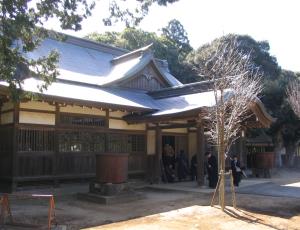 The dojo entrance at Kashima Jingu
(photo courtesy of the author)
The dojo entrance at Kashima Jingu
(photo courtesy of the author)
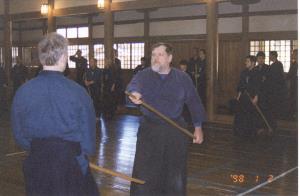 Dan and Ray during the Embu at the
Kashima Jingu (photo courtesy of
Kaminoda-s.)
Dan and Ray during the Embu at the
Kashima Jingu (photo courtesy of
Kaminoda-s.)
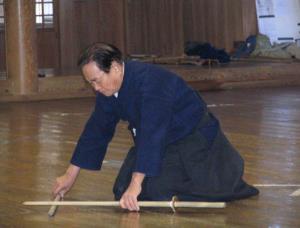 Kaminoda-s. beginning with formal
Reiho for the Embu at Kashima Jingu
(photo courtesy of Dan Pearson)
Kaminoda-s. beginning with formal
Reiho for the Embu at Kashima Jingu
(photo courtesy of Dan Pearson)
We proceeded further on to the shrine dojo where we held an embu, which
the kannushi attended. Jodo kihon and all the SMR arts were
demonstrated as well as Iaido. I managed to get on the floor to
do the first five kata from Omote with Dan. Sensei used the
opportunity to hand out scrolls for Gomokuroku, and Oku-iri. The
kannushi handed out embu menjyo (certificates for participating in the
demonstrations) to the senior student; they were later distributed to
us along with a fancy cardboard tube to put them in. After the
embu, we proceeded out the back gate into waiting cars to drive to
Tsukahara Bokuden’s gravesite in Kashima.
Trip to Tsukahara Bokuden’s Grave
(Sunday, 6 Feb. 2005)
Tsukahara Bokuden (1490-1571) is the famous kenshi associated with
Kashima Jingu; Indeed, his father was a Shinto priest at the
shrine. He learned the local fencing style, Kashima-ko, from his
father; a relative of the local lord then adopted the boy and taught
him Katori Shinto Ryu. Like Miyamoto Musashi (1584-1645) who came
after him, he went on to test his skills in duels and founded his own
style, Shinto Ryu (the name is not unique as there have been more than
one ryuha to use this name), which unfortunately did not survive past
the next generation. He left a manuscript of 98 poems
encapsulating his understanding, supposedly composed late in life while
living in a hermitage near Kashima Jingu (similarly, nineteen months
before his death, Musashi retired to a cave in Kumamoto in central
Kyushu to write his magnum opus, Gorin no Sho). Sugawara (1988)
devotes his first chapter to Tsukahara Bokuden (and his second chapter
to Musashi).
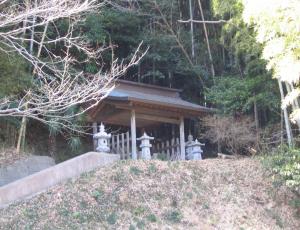 The pavilion over Tsukahara Bokuden’s
grave (photo courtesy of the
author)
The pavilion over Tsukahara Bokuden’s
grave (photo courtesy of the
author)
Tsukahara Bokuden’s gravesite is on a hillside covered in timber bamboo
that is approached from a single lane road on the dike between rice
paddies. There is a small parking lot at the foot of the
hill. The path passes by a local cemetery; there were some rather
old grave markers next to some rather recent ones. Tsukahara
Bokuden’s grave marker is under a covered pavilion about halfway up the
hill. Apparently Kendo students leave shinai as offerings.
We paid our respects, bowing and burning incense. A large group
picture was taken as we walked down. At the base of the hill, a
reading about the life of Tsukahara Bokuden took place while we drank
small cans of hot coffee. There is a waka on the gravesite that
appears in Shirakami (1987) on page 14 that I stumbled across after my
return that seems to encapsulate what I felt on my visit.
“Tall waving bamboo
By this peaceful hillside grave;
Soul of Bokuden,
Following the sword’s long path
Guiding true each hand and spirit.”
Afterwards we returned to Shimbuden for lunch.
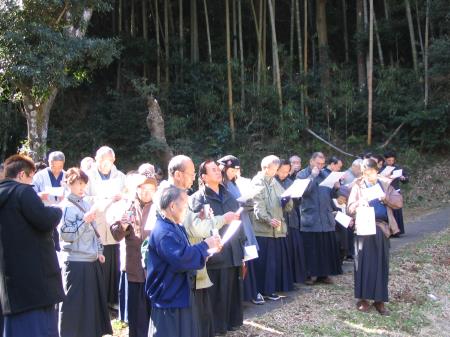 Sensei and company below the
gravesite listening to the reading of
Tsukahara Bokuden's life (photo courtesy of the author)
Sensei and company below the
gravesite listening to the reading of
Tsukahara Bokuden's life (photo courtesy of the author)
Gasshuku Day 3 (Monday, 7 Feb.
2005)
Day 3 began like Day 2: raising the flag, exercising in the dojo and
eating breakfast. We returned to the dojo after breakfast
for the final session of the Gasshuku. Our group continued
working on Kage, getting through twelve of fourteen kata with
Yamaguchi-s. (we skipped the two forms of Neya no Uchi no Kage –
Yamaguchi-s. said that is was just maki-otoshi). Finally all the
groups reassembled, and we all ran through all twelve Seitei Jo
Gata. At the end of the Gasshuku, we were all presented with
certificates of attendance. We returned to the dining hall for
lunch, our last meal together. After lunch, the majority of the
participants left. The gaijin were relocated; the seniors stayed
in Sensei’s tatami room suite, and the rest of us stayed in the
adjacent tatami room, quarters that Sensei’s senior people had occupied
during the Gasshuku.
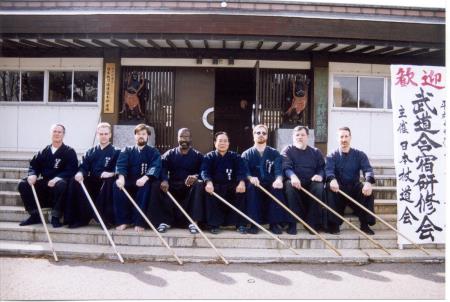 Sensei and the American students;
from left to right: Michael Rogers,
Dr. Dan Pearson, Corey Comstock, Dr. Claude Gilmore, Kaminoda-s., Peter
Boylan, myself, & Dr. Richard Friman (photo courtesy of Kaminoda-s.)
Sensei and the American students;
from left to right: Michael Rogers,
Dr. Dan Pearson, Corey Comstock, Dr. Claude Gilmore, Kaminoda-s., Peter
Boylan, myself, & Dr. Richard Friman (photo courtesy of Kaminoda-s.)
Extra-Training Day 1 (Monday, 7 Feb.
2005)
After lunch our smaller group returned to the dojo; we continued with
the “Kashima Jingu Gasshuku Experience” in the small – more intimate
and more intense. Kaminoda-s., assisted by Yamaguchi-s., ran us
through the seven o-dachi vs. o-dachi kata of Kenjutsu.
Participants included Michael Rogers and Corey Comstock (both currently
living in Japan), Drs. Richard Friman and Claude Gilmore (both from
Wisconsin), Peter Boylan (Michigan), and, of course, Dan and myself
(both from Maryland). We were joined by a Japanese woman, Sato-s.
of Osaka, who had received Gomokuroku from Sensei at the end of the
embu at Kashima Jingu. Yamaguchi-s. and Michael Rogers had to
leave at the end of the day, reducing us to a group of eight.
After dinner and a soak, we joined Sensei in his room for some drinking
– the sake was good, but the shochu, Japanese-style vodka, must be an
acquired taste.
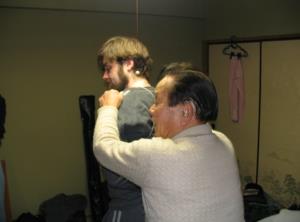 Sensei with Corey on the receiving
end of a Hojo-jutsu lesson (photo
courtesy of Dan Pearson)
Sensei with Corey on the receiving
end of a Hojo-jutsu lesson (photo
courtesy of Dan Pearson)
Sensei held an impromptu Hojo-jutsu session. Out came the hojo
(tying cords) as we tried our hands at some elementary
techniques. Sensei began to work on Corey; he trussed Corey up in
several different ways. Sensei then demonstrated a variety of
prisoner control techniques that had Corey flopping all around the
tatami room. At 77, Sensei manhandled Corey as if he were a rag
doll. It was quite the experience (but I am glad that I was a
spectator).
Extra-Training Day 2 (Tuesday, 8 Feb.
2005)
Tuesday morning dawned cold and wet, and the flag raising was
cancelled. We went to the dojo before breakfast and reviewed the
first three kata from Kage, and then Sensei instructed us in the first
of five kata from Gohon no Midare. Sensei told us that the late
Shimizu-s. created this set having been inspired by kata from Tendo Ryu
Naginata-jutsu [apparently Shimizu-s. was on friendly terms with the
14th soke, Chiyo Mitamura; similarly, Kaminoda-s. is on friendly terms
with Hanae Sawara, a classmate of the 16th soke and a senior exponent
of Tendo Ryu; I had the opportunity to train with Sawara-s. in March
1998 at a Tendo Ryu Gasshuku held at Asilomar in Monterey, CA
(Sosnowski, 1998b)]. After breakfast, we continued to work
through
the remaining four kata from Gohon no Midare. Our group shrunk
again as the two Wisconsin students departed for Narita before lunch;
now we were a group of six.
We take a longer than usual lunch break to rest. I took the
opportunity to practice my shakuhachi again; I had to go down to the
dining room so as not to disturb the others. The assistant cook
came over, intrigued by the playing and was a bit surprised to find a
gaijin. Conversation was sparse though as he spoke no English,
and my Japanese is minimal.
After lunch, Sensei first reviewed the four Kusarigama Kata from
Saturday night’s training, and then added one more kata from the Ura
set. Sensei then switched to the SMR Omote set, and he covered
the first three kata in detail, pointing out a number of
subtleties. After a hot bath and dinner, we again retired to
Sensei’s quarters for sake and budo talk.
During the evening, Sensei signed my Kusarigama-jutsu and Jutte-jutsu
& Hojo-jutsu books (he had signed my copies of Jodo Kyohan and
Jyodo during the 1999 Gasshuku in Maryland) – “signing” in this case
amounts to a full page of signed and sealed calligraphy. He also
shared with us a bottle of fine sake from Kashima Jingu – it was like
the liqueur Geldwasser in that it had small flakes of gold foil in
it.
He was free with his opinions concerning people, events, and
organizations within the Jodo world, especially his relationship with
the late Shimizu-s. (Kaminoda-s. was with Shimizu-s. daily – in the
dojo, the Tokyo Riot Police training center, and in the office as
Kaminoda-s. was the personal secretary to Shimizu-s.). With
respect to waza (techniques), he was especially adamant about the role
of uchitachi in the various SMR arts.
Extra-Training Day 3 (Wednesday, 9
Feb. 2005)
Our last day dawned cloudy and freezing – puddles of rain had turned to
ice. We all trooped into the dojo for pre-breakfast
training. Sensei reviewed the seven o-dachi vs. o-dachi kata of
Kenjutsu that we had trained in on Monday afternoon, and then went on
to instruct us in the one nito vs. o-dachi kata and the four o-dachi
vs. ko-dachi kata. After breakfast, Peter Boylan left by train
for Narita and his flight home to Michigan. The five of us
returned to the dojo after breakfast for our final training
session. We opted for a session of Jutte-jutsu (given the
Gasshuku and the extra training, the only thing that we did not do was
Tanjo-jutsu). Sensei led us through five kata, four from the
Omote set and one from Ura. Sensei himself was uchitachi using an
iaito (real jutte do not work well with bokuto) he is quite a scary
sight coming at you with his sword in hasso – I felt like a man
overboard in the water with an approaching ocean-going tug boat bearing
down on me at full throttle.
During the morning break with those ubiquitous little cans of hot
coffee, Sensei asked the three remaining gaijin to demonstrate three
kata from Iaido; Sensei himself is a senior exponent of Muso Shinden
Ryu Iaido. After Corey and Dan, Sensei turned to me and asked me
to do a single kata, knowing that I was from a different style (Muso
Jikiden Eishin Ryu), saying that he could assess my Iai with just one
kata (which I know to be true). So I did ipponme Mae from the
Shoden set (Omori Ryu) of MJER. Sensei commented that it was a
strong demonstration, and that my teacher was from the Osaka area
[actually, my late guiding instructor, Matsuo Haruna (1925 - 2002),
Iaido hachidan/hanshi, whom I saw annually from 1997 through 2001, was
from nearby Okayama Prefecture]. After break, we returned to
Jodo, running through the Omote-level kata a number of times.
Then the clock ran out, and it was time to return to the dorm for lunch
and final packing.
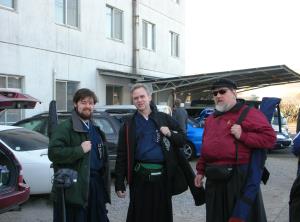 “The boys from Maryland” at Kashima
Shimbuden: Corey (left) attended
St. John’s College in Annapolis, MD, in the late 1990’s; Dan (center)
and myself (right) currently reside in Maryland (photo courtesy of
Michael Rogers)
“The boys from Maryland” at Kashima
Shimbuden: Corey (left) attended
St. John’s College in Annapolis, MD, in the late 1990’s; Dan (center)
and myself (right) currently reside in Maryland (photo courtesy of
Michael Rogers)
Departure (Wednesday, 9 Feb.
2005)
After lunch, we brought all our gear down; both Kaminoda-s. and Sato-s.
packed all of their stuff in boxes and had them shipped back home – it
works well for them in Japan. That left just the three gaijin
with gear. We all piled into the Shimbuden van for the short ride
to the Kashima bus station. The staff of Shimbuden came out to
bid us all farewell. The five of us said good-bye at the bus
station. Kaminoda-s. would return to Tokyo, Sato-s. to Osaka, and
Corey to Sendai where he now lives, and studies with Kaminoda-s.’s
designated successor, Osato Kohei sensei, who is also a veteran of the
Maryland Jodo Gasshuku (1996, 1997, 1999, and 2000), and who also
attended this Gasshuku but had been working with groups other than
ours.
Dan and I hopped in a taxi for Narita driven by an old Japanese
gentleman who spoke no English; however, we did get there and dropped
off at the proper terminal. We had a couple of hours to kill –
Dan dropped off his rented cell phone, we had coffee, and did some gift
shopping. We said good-bye before checking in – as we had
different carriers at almost opposite ends of the terminal, chances
were slim of seeing each other once we checked in and passed through
security, and customs & immigration.
I needed a book to read on the flight back as I had already read the
two that I had brought (Bones of the Master: A Journey to Secret
Mongolia by George Crane, and Enigma: How the Poles Broke the Nazi Code
by Wladyslaw Kozaczuk and Jerzy Straszak) on the flight to Japan – only
during long flights do I have the luxury to read uninterrupted for long
period of time. In the airport bookstore, I found The Last
Shogun: The Life of Tokugawa Yoshinobu, a work of historical fiction by
Ryotaro Shiba, to read on the way home; I had previously read his Drunk
as a Lord: Samurai Stories, and had enjoyed it immensely. After
this, I went to the currency exchange to change my yen back into
dollars, and then wait to board my long flight home.
Sensei’s Post-Gasshuku Mailing
On 23 February 2005, the postman delivered a fat airmail envelope,
which had Kaminoda-s. return address. With great excitement, I
opened the envelope and examined the contents. There was a letter
from Sensei with a report of the February 2005 Kashima Jodo Gasshuku
and a receipt for my payment. The “fat part” was a series of
photographs: six of them were group photos taken at Kashima Shimbuden,
Kashima Jingu, and Tsukahara Bokuden’s gravesite, and four were candid
photographs from the embu at Kashima Jingu. I am simply touched
by his thoughtfulness.
Lessons Learned
On a personal level, I found the following lessons throughout our
training:
- “Be prepared (for anything, especially change)” [it’s not just
for
Boy Scouts].
- "Maintain zanshin constantly.”
- “Practice with kokoro/shin.”
Comparing my previous experiences at the five Maryland Jodo Gasshuku
with my experience at the Kashima Jodo Gasshuku, it seems to me that
they were rather similar: the “Kashima Jingu Gasshuku” experience is
essentially the group intense-training experience with emphasis on the
group. The Japanese experience had some unique aspects that could
not be duplicated at the 1998-2000 Maryland Gasshuku: authentic
Japanese food, sleeping quarters and bathing as well as o-daiko,
shinza, dojo, and the old jingu.
Acknowledgements
First and foremost I wish to thank Kaminoda-s. for his generous
teachings over the years. Sensei’s senior students, Yamaguchi-s.
and Abe-s., provided much of our instruction during the Gasshuku.
Mr. Araki provided transportation for us from Tokyo to Kashima, and was
our guide at Katori Jingu. Dr. Dan Pearson, who provides the
leadership to our local Jodo group, was a wonderful traveling companion
and provided much of the detailed information on how to travel and
train in Japan (we have both come a long way since our first meeting in
Guelph, Ontario, in July 1996). Mr. Corey Comstock provided
training pointers and real-time translations during the Gasshuku.
Mr. Michael Rogers provided us with a lot of information on the
Gasshuku before we left, an information packet when we arrived, and
real-time translations as well as delivering those suede-soled tabi so
we could be a bit more comfortable in the unheated dojo. Dr.
Richard Friman provided additional insights on Budo and other things
Japanese, especially how to eat natto (boiled soybeans fermented by
yeast) for breakfast. I have known Mr. Peter Boylan for years –
we bump into each other in Guelph once or twice a year it seems since
at least 1997. Peter also provided real-time translations as well
as additional insights on Budo and other things Japanese like
ofuro. Lastly I wish to thank my wife, Ms. Val Matthews, for all
her support in my pursuit of Budo, and especially in planning and
executing this trip, my first to Japan.
References
Amdur, Ellis, 2002. Old School: Essays on Japanese Martial
Traditions, Edgework, Seattle, WA. 275 pp.
Bocking, Brian, 1997. A Popular Dictionary of Shinto, NTC
Publishing Group, Lincolnwood, IL. 251 pp.
Draeger, Donn F., 1973. Classical Budo, The Martial Arts and Ways
of Japan: Volume II, Weatherhill, New York, NY. 127 pp.
Shirakami, Ikku-Ken, 1987. Shuriken-do: My Study of the Way of
the Shuriken, Paul H. Crompton, London, England, 128 pp.
Sosnowski, Raymond, 1998a. “The Second Annual [Oct. 1997] Shindo
Muso Ryu Gasshuku in MD” Journal of Japanese Sword Arts #93, 10(7/8),
4-7, July/August.
_____, 1998b. “Shingetsukai Tendo-Ryu Naginata-jutsu Gasshuku
[Mar. 1998] at Asilomar,” Journal of Japanese Sword Arts #94, 10(9),
5-9, September.
_____, 1999. “The Third Annual [Oct. 1998] Shindo Muso Ryu
Gasshuku in MD – the Kashima Jingu Gasshuku Experience,” Journal of
Japanese Sword Arts #99, 11(2), 3-9, February.
_____, 2000. “The Fourth Annual [Oct. 1999] Shindo Muso Ryu
Gasshuku in MD – the Kashima Jingu Gasshuku Experience Revisited,”
Journal of Japanese Sword Arts #106, 12(1-2), 11,13-15, March/April.
_____, 2001. “The Fifth Annual [Oct. 2000] Shindo Muso Ryu
Gasshuku in MD – the First US Inkyo,” Journal of Japanese Sword Arts
#112, 13(3-4), 10-15, March/April.
Sugawara, Makoto, 1988. Lives of Master Swordsmen, The East
Publications, Tokyo, Japan. 157 pp.
